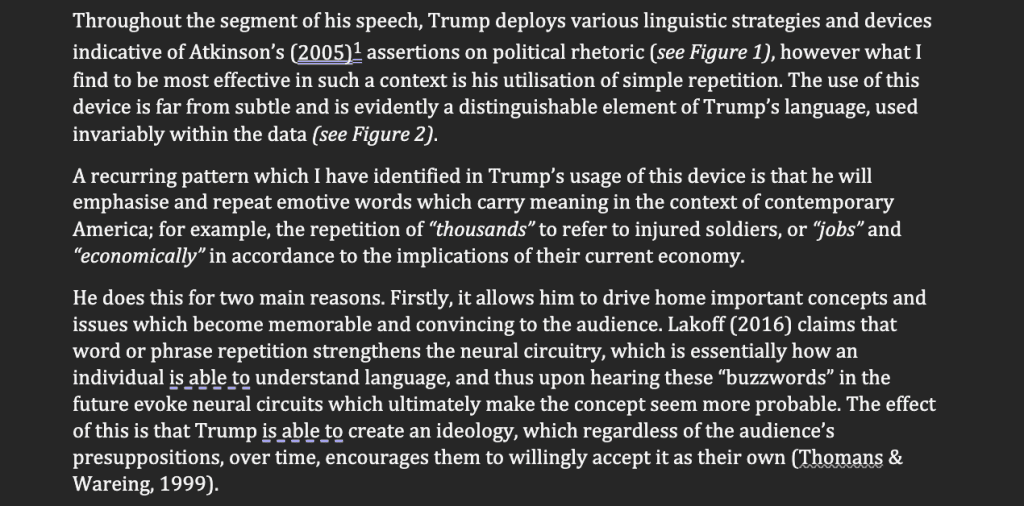Is the best marketing strategy one that wins you followers… or one that divides?
It’s Election Day in the U.S. and here we are again.
Trump’s on the ballot, his wispy hair centre of the spotlight. And I can’t help but think back eight years ago, when he first ran for President.
At that time, I was just an A-Level student, deep into my English Language coursework, oblivious to how strangely relevant it would all feel today.
My dissertation? A language investigation centered on Trump himself.
I’d chosen him for one reason: he was everywhere. Headlines. News cycles. Social feeds. Like it or not, he was dominating conversations with a language that didn’t sound like any politician we’d heard before.
So, as the curious student I was, I set out to uncover the mechanics—how he was using language as his own form of artillery.
Turns out, Trump’s language was anything but accidental. Patterns started to emerge. Little devices and tricks that, on the surface, seemed almost too obvious to be powerful.
Repetition was his weapon of choice. The same phrases, repeated endlessly, like a drumbeat underscoring everything he said. It seemed boring, even lazy, at first glance. But it was doing something powerful. Those phrases were embedding themselves into the public consciousness, and, over time, they took root.

A whole bunch of waffle from a 17 year old trying to sound smart.
And then there was his tone—defiant, unpolished and unapologetically blunt. It fast became clear that this millionaire tycoon, stepping into the foreign world of politics, wasn’t trying to fit in, but exactly the opposite. No fluffy language. No high-and-mighty phrasing. He was speaking in a way that was raw, direct, and familiar.
And that was his trick.
He’d throw on his MAGA hat, lean into the microphone, and make his case as if to say, “I get you. I’m one of you.” His campaign wasn’t against Hillary Clinton; he was running against the whole idea of the “politician.”
At the time, I thought I was onto something big. So I wrote it all up, handed it in, and got my grade. An ‘A.’
And, funny enough, so did Trump.

Trump delivering his victory speech (2016).
The Master of Dark Influence
Eight years on, I’m not an English student anymore—but as a marketer, I’m studying his methods more than ever. Trump’s tactics have bled out of the classroom, becoming common currency in our field, leaving a mark that’s impossible to ignore.
If Hogwarts were a school of marketing, Trump would be the unflinching professor of the Dark Arts, only, unlike the usual Dark Arts professors, he’d last a lot longer than a year. He’s the thorn in the Democratic party’s side, a rash that won’t go away, and one that only seems to grow stronger with every attempt to rub it out.
But let’s be clear: Trump didn’t invent these techniques.
Marketing and political campaigns have used polarisation, bold statements, and repetition long before he entered the scene. What he has done is amplify them. He brought these methods into the spotlight in a way few had before, giving them a platform they’d never quite had.
And that’s why Trump’s methods are relevant to us here, too. Because, just like a campaign to sell a product or a service, political campaigns are about selling an ideology, a future, a feeling.
In our little corner of the world as marketers, where visibility is everything, these tactics do what they’re meant to: they capture attention, spark strong emotions, and keep people watching. Powerful, no question. But is it worth the cost?
Because here’s the other side of it: when the aim is always to provoke, to polarise, and to spark division, where does it lead? Trump’s approach has turned attention into a currency, but it also pushes boundaries, tests limits. Is marketing just about who’s the loudest—or is there a line?
So here’s a closer look at the “unforgivable curses” that eight years of Trump campaigns have taught us. The tactics that, while powerful, make us wonder where the line truly lies—and what happens when we cross it.
Trump doesn’t just pick a side—he builds walls between them.
Close your eyes. Picture a Trump supporter.
MAGA hat. Southern drawl. Gun owner. Maybe even a pickup truck with a flag waving off the back. Certain images come to mind, right? But that alone doesn’t win elections.
Trump’s appeal goes beyond a single demographic. His strategy targets groups who feel left out, the ones who feel unseen by the establishment. Take young men.
Scott Galloway, a Democrat, author, and speaker, recently appeared on Stephen Bartlett’s podcast Diary of a CEO and pointed out a glaring oversight:
“If you go on the Democratic Party’s website, there’s a section that says ‘who we serve.’ It lists 16 demographic groups, but not one mention of the group that has fallen the furthest in the United States… young men.”
This is where Trump’s marketing takes a different route. He doesn’t just choose a side—he builds walls around it. You’re either with him, or you’re not. And for young men who feel ignored, that choice is powerful.

And in marketing, being seen is everything. Because when an audience feels overlooked, they’ll look for the a voice that acknowledges them—even if that voice comes with a cost. Under Trump, young men could face the largest tax increase. But when the alternative is feeling invisible, that trade-off starts to feel worth it.
Democrats, as Galloway points out, seem to fight for everyone—except them. Men make up 3 out of 4 homeless people. They’re three times as likely to take their own lives. Twelve times as likely to be incarcerated.
In response, Trump offers more than just loyalty. He taps into outrage. And for those who feel left behind, that’s a powerful draw.
Outrage sells, and Trump knows it.
Controversy isn’t a problem for Trump. It’s a gift.
Just this past week, Tony Hinchcliffe, a comedian, was standing on stage at a Trump rally.
He’s got the mic, the audience, the energy. And then seemingly out of nowhere he calls Puerto Rico a “floating island of garbage.” The backlash is instant. News headlines light up. Social feeds explode.
Even Biden joins in. He calls out Trump’s base directly, saying, “The only garbage I see floating out there is his supporters.”
Most campaigns would be scrambling for damage control. Apologies, clarifications, spin. Not Trump.
A few days later, he’s in Wisconsin. A rally stop, but he doesn’t arrive in a motorcade. No, he quickly jumps on the opportunity, rolling up in a garbage truck before his fresh coat of spray tan has the chance to set.
Bold letters, campaign slogans plastered down the side. A message that’s as loud as it is clear.
Each controversy keeps him in the spotlight, each reaction fuels the next. Where most would see a PR nightmare, he sees a platform.
And it works. Outrage doesn’t fade, doesn’t get buried. It sticks. It pulls focus back to him, to his message, on his terms.
But there is a cost. The more he provokes, the more divided we become. In the case of Trump, that division isn’t just part of the strategy—it’s the ultimate goal.
To Trump, critics are unpaid marketers.
Trump knows exactly what he’s doing. He throws out a comment, steps over a line, takes a jab—and waits. The response is inevitable.
Outrage. Headlines. Backlash.
But this isn’t damage control; it’s part of the plan. The louder his critics get, the more airtime he gets. They can’t help themselves, and he knows it.
Scott Galloway captures it:
“He’s unpredictable. I publicly endorse Vice President Harris, but one thing I hate about my party, quite frankly, is we’ve become f***ing humourless. Everything is offensive, and people are just so sick of that. Then Trump showed up and started saying these really offensive things, and that felt raw, felt authentic, and really appealed to people.”
And it’s true—every time his critics react, they hand him exactly what he’s looking for. Free press, free reach, and a fresh chance to remind his supporters why he’s the “anti-politician.”
Because when they’re focused on taking him down, they’re building him up.
When in doubt, keep it simple—and shout it loud.
Trump’s messaging isn’t subtle. It’s not meant to be.
He doesn’t drown his audience in policy details or endless explanations. He sticks to the basics. Blunt phrases. Bold ideas. The kind you can’t ignore, even if you try. And then he repeats them. Over and over, until they’re impossible to shake.
Build the wall.
Fake news.
Make America Great Again.
Simple? Sure. But that’s the point. These slogans don’t just linger—they lodge themselves into the public’s mind. In a media landscape flooded with information, Trump’s slogans are like alarm bells, slicing through the noise.
He understands something fundamental: complexity doesn’t stick. In a world obsessed with immediacy, he strips his message down to the bone, boiling each idea down to a phrase that anyone—supporter or critic—can repeat.
And they do. His critics dissect them, his supporters chant them, and all the while, the message spreads. Because in a crowded room, people remember the loudest voice.
And he makes sure it’s his.
What if this isn’t marketing at all?
At first glance, Trump’s approach looks like bold marketing. But maybe it’s something more.
These tactics don’t just grab attention; they hold it in a vice.
They don’t only spark conversation, they dictate it.
His methods create a loop of visibility that doesn’t rely on persuasion as much as pressure, pulling people in whether they agree with him or not. It’s the kind of influence that goes beyond connection and inches closer to control.
And that’s where the line starts to blur.
Trump has taken techniques we recognise—branding, repetition, loyalty-building—and stretched them into something… different.
Something sharper, louder, and harder to shake off.
Influence, or control?
Loyalty, or dependency?
And how do we even begin to tell the difference?
The unsettling truth? These tactics work. People listen. People follow. They repeat his phrases, wear his slogans, rally under his message. And as they do, he shows us that influence can be relentless, even unyielding, when wielded without limits.
So we’re left with a question: do we really want to take a page out of this book? Can we borrow from a strategy that doesn’t seem to know when to stop?
Maybe Trump’s biggest impact won’t be in the policies he makes or the battles he wins. Maybe it’ll be in the questions he leaves behind— ones every marketer will have to answer. And as his tactics shift the very idea of influence, we have to decide what we’re willing to change, and what lines we won’t cross.
Standing out without going dark
So where does that leave us?
Trump’s tactics work, yes. They grab attention, hold it, and command loyalty. But as marketers, do we really have to go down that road?
In marketing, you don’t have to go dark to stand out. It’s not the volume or the controversy that makes a message stick—it’s the connection. And that’s something you can build without drawing lines in the sand.
Take simplicity. Trump’s approach is proof that the simplest phrases, the clearest ideas, cut through the noise. But simplicity doesn’t need to shock. Sometimes, it’s a straightforward message that resonates most, without the need for drama.
Or take loyalty. Loyalty can be built by inspiring people, not dividing them. Instead of “us versus them,” create an “us.” A shared story. A common ground that doesn’t alienate, but brings people closer.
Boldness? Yes, it matters. Being memorable is essential. But in a world that’s already overloaded with voices fighting for attention, sometimes the most powerful thing you can do is stay genuine. To be the voice that doesn’t shout over others but speaks clearly, authentically, to those who want to listen.
Trump’s legacy may be one of division, of lines drawn, of boundaries pushed. But it also reminds us of this: that influence doesn’t have to be ruthless. That in marketing, it’s possible to stand out by standing together.

